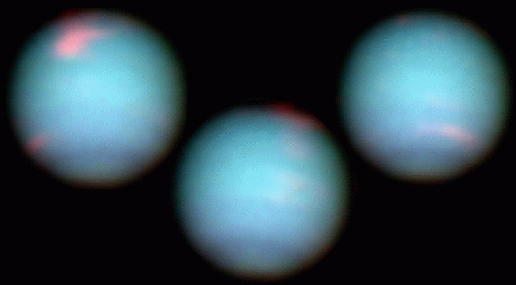Astronomy Picture of the Day
Discover the cosmos!
Each day a different image or photograph of our fascinating universe is
featured, along with a brief explanation written by a professional
astronomer.
May 7, 1996

The Clouds of Neptune
Credit:
H. Hammel (MIT) and
NASA
Explanation:
These Hubble Space Telescope (HST) images reveal glimpses of the
dynamic
atmosphere of Neptune, the Solar System's
most distant gas giant planet.
The first close-up of Neptune's clouds was provided by
NASA's Voyager 2 spacecraft during its August 1989 flyby, giving
a tantalizingly brief look.
From its vantage point in Earth orbit, HST can patiently
watch in detail as the
planet's massive weather systems change over time. These three
pictures, taken during October and November 1994 when
Neptune was
only 2.8 billion miles distant, show the planet's characteristic aqua-blue
colored atmosphere highlighted by pink, high altitude clouds and streaked
with dark bands. The aqua-blue color is caused by gaseous methane
which absorbs red light.
Here, the high altitude clouds were intentionally given a pink tint
to indicate that they were imaged in
near infrared light - in true color images they would appear white.
Tomorrow's picture: The Great Dark Spot: Gone But Not Forgotten
| Archive
| Index
| Search
| Glossary
| Education
| About APOD |




Authors & editors:
Robert Nemiroff
(GMU) &
Jerry
Bonnell (USRA).
NASA Technical Rep.:
Sherri
Calvo.
Specific rights apply.
A service of:
LHEA
at
NASA/
GSFC




